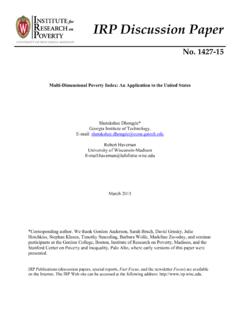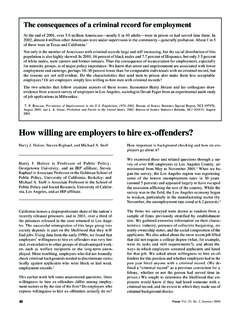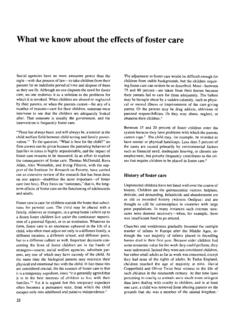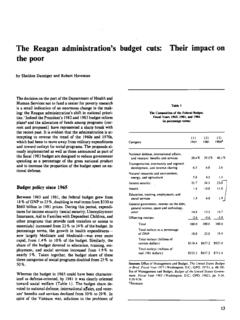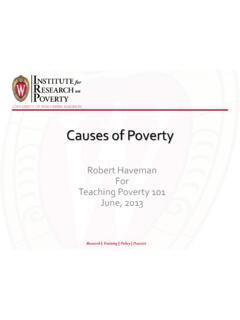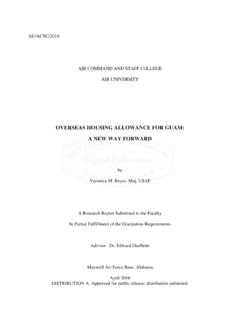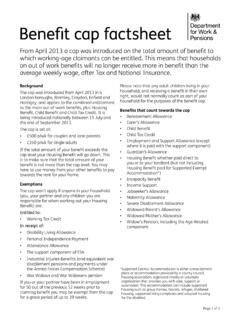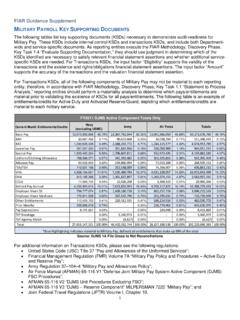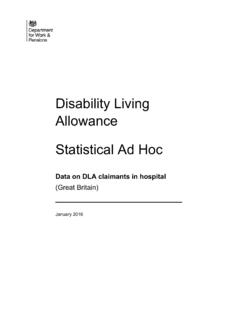Transcription of The Benefits and Costs of the Section 8 Housing Subsidy ...
1 Institute for Research on Poverty Discussion Paper no. 1380-10 The Benefits and Costs of the Section 8 Housing Subsidy Program: A Framework and First-Year Estimates Deven Carlson Institute for Research on Poverty University of Wisconsin Madison E-mail: Robert Haveman Department of Economics and La Follette School of Public Affairs University of Wisconsin Madison E-mail: Thomas Kaplan Institute for Research on Poverty University of Wisconsin Madison E-mail: Barbara Wolfe La Follette School of Public Affairs, Department of Economics, and Population Health Sciences Institute for Research on Poverty University of Wisconsin Madison E-mail: May 2010 The research presented in this paper was generously supported by a grant from the John D. and Catherine T. MacArthur Foundation. We gratefully acknowledge that support. Helpful comments on an earlier draft by David Weimer and Jens Ludwig are appreciated.
2 IRP Publications (discussion papers, special reports, Fast Focus, and the newsletter Focus) are available on the Internet. The IRP Web site can be accessed at the following address: Abstract The Section 8 Housing voucher program serves nearly 2 million low-income families in the United States. The purpose of the program is to enable low-income families to improve the quality of their Housing and to move to better neighborhoods. Voucher recipients seek Housing in the private rental market, and use the voucher to subsidize their rent. In this paper, the authors provide estimates of the social Benefits and Costs of the Section 8 Housing Subsidy program. The authors find that the Section 8 program meets the efficiency standard of positive net Benefits . For society as a whole, total Benefits (measured in annual, per recipient units) range from about $7,700 to $9,600, while total Costs are about $7,000; net Benefits range from about $650 to $2,800 per recipient case per year.
3 The social benefit- cost ratio ranges from to The bulk of the Benefits are experienced by voucher recipients, while other members of society bear the bulk of the Costs . The authors conclude that the program meets the efficiency standard of welfare economics. Keywords: Section 8; Housing voucher; low-income families; subsidies; cost -benefit analysis The Benefits and Costs of the Section 8 Housing Subsidy Program: A Framework and First-Year Estimates I. INTRODUCTION The Section 8 Housing voucher program serves nearly 2 million low-income families in the United on the social Costs and Benefits of the Section 8 voucher program goes back to the early 1980s, when Weinberg (1982) described the direct Benefits of the program and presented estimates of some of them. Reeder (1985) also estimated the direct Benefits and Costs of the Section 8 Existing program, and he extends earlier work by estimating the changes in consumption patterns induced by the program as well as the distribution of Benefits under the program.
4 About two decades later, Johnson et al. (2002) provided an outline of a benefit- cost analysis of Housing mobility programs that allow low-income families living in public Housing to move to higher-income neighborhoods. The purpose of the program is to enable low-income families to improve the quality of their Housing and to move to better neighborhoods. Voucher recipients seek Housing in the private rental market, and use the voucher to subsidize their rent. The specific amount of the Subsidy the share of the rental charge covered by the voucher is dependent upon the family s income. In this paper, we provide estimates of the social Benefits and Costs of the Section 8 Housing Subsidy program. We present our estimates on an annual, per-recipient basis, and our estimates primarily reflect changes that are observed in the initial year of voucher receipt.
5 2 1 The Section 8 designation refers to the program s statutory authorization under Section 8 of the United States Housing Act of 1937, as amended by the Housing and Community Development Act of 1974. Although the official title of Section 8 tenant-based assistance is now the Housing Choice Voucher Program, most researchers and administrators still refer to it as the Section 8 voucher program. We use the Section 8 designation in this paper. These authors review the empirical evidence on each of the potential effects they identify, but they do not provide a dollar estimate of the net societal value of the program. 2 Johnson et al (2002) discuss a full set of possible effects of the program and conclude that only a short-run partial benefit cost analysis of Housing mobility programs is currently possible.
6 2 To our knowledge, there are no quantitative estimates of the social gains and losses associated with the Section 8 program beyond these. Like previous studies, this analysis provides estimates of the direct Benefits and Costs associated with the Section 8 voucher program. However, we extend prior work by providing monetary estimates of a number of indirect Benefits and Costs of the program as well. Our benefit and cost estimates rest largely on a series of studies in which we estimate the effects of voucher receipt on a variety of recipient living unit behaviors, including movement to new neighborhoods, employment, earnings, and the receipt of a variety of public Benefits : child care subsidies, medical care assistance (Medicaid and the state Children s Health Insurance program), and welfare (TANF) our analysis, we rely on the basic principles of welfare economic theory, and adopt a comprehensive accounting framework that distinguishes impacts on voucher recipients, other citizens, and society as a whole.
7 We attempt to provide monetary estimates of Benefits and Costs , but in one case we are only able to describe the potential effects. For outcomes we have not explicitly studied, we draw on available literature to construct benefit and cost estimates. II. THE Section 8 VOUCHER PROGRAM The government currently provides Housing assistance to low-income renters through three primary programs: Section 8 tenant-based subsidies (since 1999 officially known as the Housing Choice Voucher Program); Section 8 unit-based assistance, under which building owners receive government 3 See Carlson et al. (2009), which summarizes our estimates of the effects of voucher receipt on a variety of outcomes. In these studies, we use detailed information available in administrative records from the State of Wisconsin, and supplement this information with data from the Census Bureau.
8 Our sample begins with all cases that applied for or received welfare-type transfers between 2001 and 2003, yielding three separate calendar year cohorts. Within each cohort, we form two unique groups, one composed of cases that first received a public rental Subsidy in that year, and the other made up of cases that did not. We then pool these three calendar year cohorts to create our final estimation sample. To obtain a balanced comparison group that allows for valid inference regarding the effect of voucher receipt on the outcomes of interest, we employ a propensity score matching procedure. Then, using this balanced sample, we isolate the effect of voucher receipt on the neighborhood quality and household composition outcomes using a difference-in-differences regression adjustment. All of these studies are available from the authors, on request.
9 3 subsidies to reduce rents; and publicly owned Housing units. All three forms of assistance are administered by over 3,000 local public Housing authorities (PHAs). Each of these programs represents an important policy lever, but this analysis focuses on the social Costs and Benefits of the Section 8 tenant-based Subsidy program. Section 8 tenant-based vouchers currently serve about million families nationally, including more than 850,000 families with minor children ( Department of Housing and Urban Development 2007). The primary objective of the program is to enable very low-income families to choose and lease or purchase safe, decent, and affordable privately owned rental Housing . 4 Voucher recipients, whose income must be below 50 percent of the median income of the county or metropolitan area in which they live, choose rental Housing available in the private market and contribute 30 percent of their incomes toward The Section 8 program then pays the difference between the tenant contribution and actual rent, up to a locally defined fair market rent payment A main motivation undergirding the Section 8 program is to deconcentrate the poor by making it possible for voucher recipients to leave public Housing projects and move to better neighborhoods near better jobs ( Department of Housing and Urban Development 2000).
10 7 4 5A PHA must provide 75 percent of its vouchers to applicants whose incomes do not exceed 30 percent of the area median income. 6 This standard is set by the Department of Housing and Urban Development (HUD) at the 40th percentile of the local rental market, as calculated by the monetary value of leases commenced in the previous year. The payment standard is typically between 90 percent and 110 percent of area fair market rent. 7As the program has expanded over time, a number of constraints have partially interfered with the goal of geographic mobility for recipients of tenant-based assistance. One constraint has been the limited geographic span of many local PHAs that serve only parts of metropolitan areas, reducing the possibility for recipients to move to neighborhoods with a smaller concentration of poor families.


